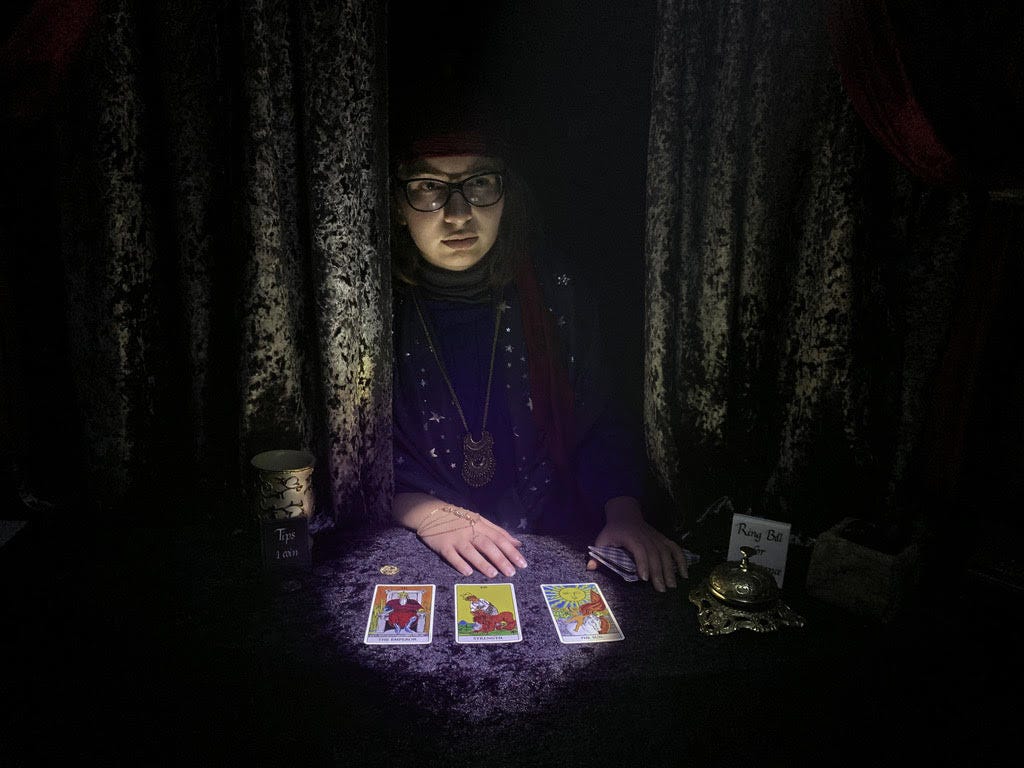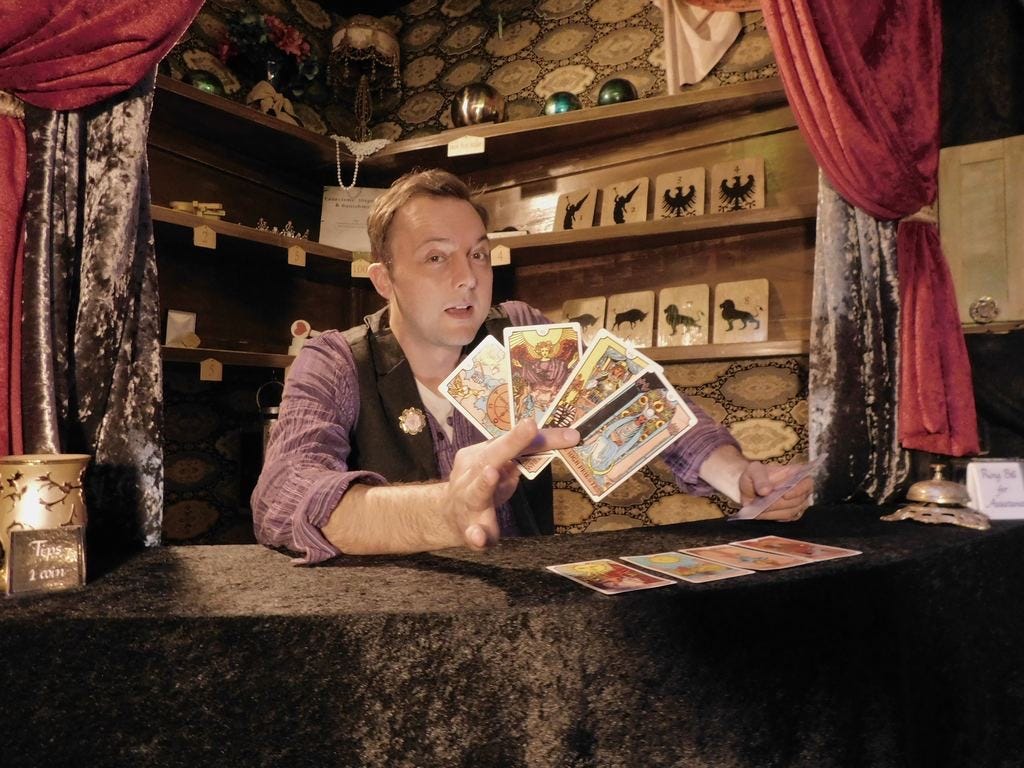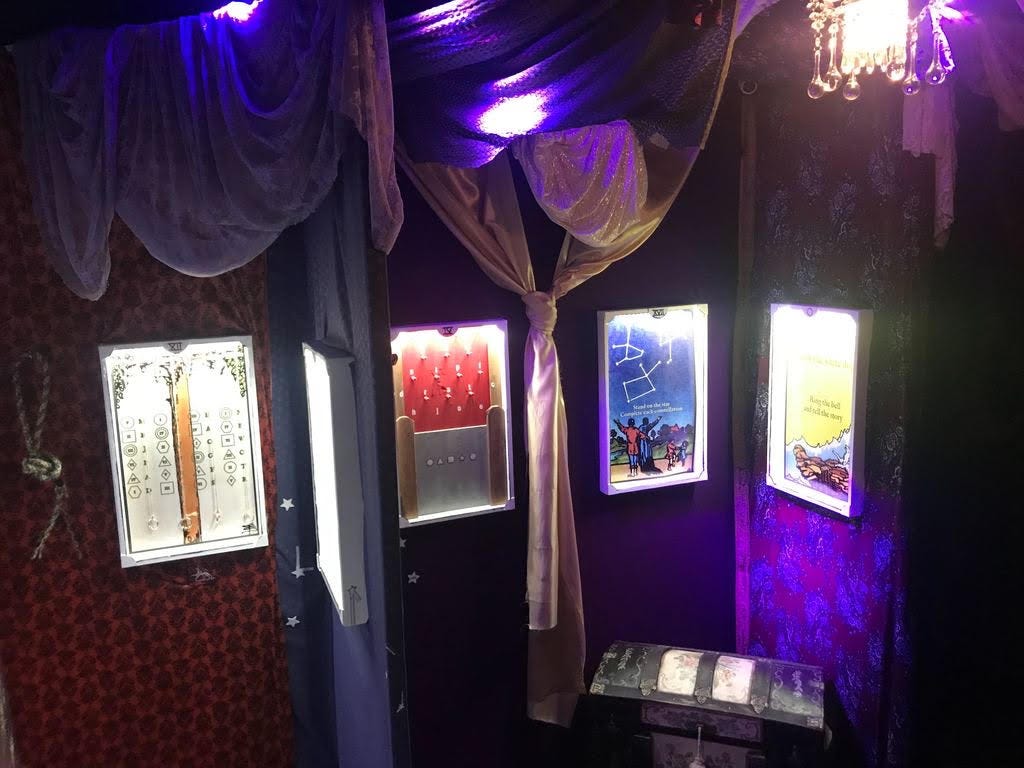‘The Fortune Teller’ Throws A Wild Card into the Escape Game Genre (Review)
Kevin Gossett and Kathryn Yu discuss Level Games’ Tarot-themed escape room-theatre hybrid


Dramatis Personae:
Kevin Gossett — NoPro LA Reviews Editor
Kathryn Yu — Executive Editor
Note: Spoilers abound.
Kevin: I wasn’t sure what to expect from Level Games’ new escape room, The Fortune Teller other than that it had a live actor in it. And even that wasn’t a lot to go on, so my biggest question going in was “What role will the actor take?”
Kathryn: Escape rooms with actors in them are both rare and hard to pull off successfully. Before we went through the game, I was curious how having an actor in the room would change the dynamics of game play.
I’ve been in escape rooms before where you feel as if you’re being rude by focusing on the task at hand and not engaging with the performer. Conversely, if the performer is also the game master and gives you all of your hints in character (and slowly because they’re theoretically a very old man), that can also be irritating. The description on their site says that engagement with the live character is “crucial to your journey,” so I was cautiously optimistic about how it would play out: maybe someone’s been able to seamlessly integrate simultaneous puzzles and performance?!
Kevin: So, the premise of the room is that you’ve stumbled into a fortune teller’s, uh…fortune telling space and you can ask for a reading. Surprise surprise, something’s gone wrong and Grace, the proprietor of the fortune-telling establishment has disappeared after interacting with a special deck of Tarot cards, so her protege, Matthias has to give the reading.
Kathryn: The first few minutes were a little off for me because I was expecting something a little spooky and serious, but it became clear through the actor’s performance that they were going for something a bit more campy. Perhaps leaning into camp fit the theme better because we were about to play a bunch of mini games — there’s always going to be a conflict between frantically-paced 10-minute games and a “serious” theme. So once the gameplay really got off and going, that tonal mismatch faded away.
Kevin: I agree and it took a few minutes to grasp what the room was doing and how Matthias played into it: he does a reading and then reveals that he needs your help finding Grace. To do that, he’ll use Grace’s Tarot deck.

Every round, Matthias draws three or four cards which correspond to “puzzles” (but as you said, really more mini games) around the space. After the cards are dealt, Matthias would close off his curtain until the round was over unless you needed a hint.
Finish the game, and that clears the card and moves you towards helping to find Grace. Each round is also on a timer, but you don’t know exactly how long each one lasts and it may just be up to the game master’s discretion depending on how much time you have left in your session
Players are also given a few coins at the start of the room to spend on items that will help you solve the puzzles or ask for hints. Finishing puzzles nets you more coins. I think that covers the rules of the game and typing them out makes them seem more confusing than they really are.
Kathryn: I also was a little unclear as to why the fortune teller kept closing his booth and drawing the curtains on it. Maybe I missed an explanation for why he needed to keep hiding and returning. It’s a clever solution for players feeling like they have divided attention, I just wished for a narratively-driven reason for why he was behaving the way he was.
Kevin: Him hiding in between rounds didn’t bother me that much and while I would have liked a better story explanation, I assumed it was sort of practical for checking your puzzle solutions and setting up future rounds. And it wasn’t like he was totally off limits, you could ask for a hint or ring the bell and chat with him a little bit, which gave him a chance to improv a little bit based on what you wanted.
Kathryn: Unlike a traditional escape room where there’s either a countdown clock or timer visible or periodic reminders of how much time you have left, I didn’t feel like I really knew “where” I was in the progression of the experience. The Fortune Teller is described as taking 75 minutes but we were there for longer than that. It was ambiguous as we became stuck in the cycle of interacting with the performer, solving some puzzles, interacting again, solving more puzzles, etc. So I really had no idea how much time had passed and how close we might be to the crescendo of the piece.
Get No Proscenium’s stories in your inbox
Join Medium for free to get updates from this writer.
SubscribeSubscribe
Kevin: Yeah, it really isn’t an escape room in the traditional sense. You’re not racing the clock, you’re not trying to get out, and it seems like unless you’re particularly fast on all of the mini games (unlikely as several have a distinct learning curve), you’ll be in there for the full 75 minutes. There isn’t even a lock in the room. That’s not a bad thing though!

Kathryn: Without spoiling too much, I found that “mini games” were varied and interesting and the fast-paced nature of each round meant that each person got to try several different puzzles throughout the course of the night. Each mini game was mounted on the wall, as if it were a framed 3D Tarot card, and some had elements that could only be obtained by trading in your coins, but this meant it was very obvious which physical props were meant for which puzzles. By riffing off the imagery of the Tarot cards, we had to follow constellations, put weights on scales, rotate sun dials, and more. Some even relied purely on physical dexterity. The tactile nature of the puzzles was great; it was like the Tarot cards themselves were coming to life in front of us.
Kevin: The mini games are a lot of fun and range from brain teasers to what are basically party games. One you and I worked on together had us both giggling and stressing out as we tried to finish it without screwing up. And, with the mechanism of multiple cards each round, everyone in our group of four was able to try something out every time. This also helps avoid a problem of some escape rooms where your best players can dominate and leave others feeling left out.
Kathryn: It felt odd that we were able to progress through the experience regardless of solving any particular puzzle and it didn’t matter which of the given puzzles we solved — they felt almost random and unrelated to the ending. My writing instructor talks about how endings to stories should feel both inevitable and unexpected at the same time. The culmination of The Fortune Teller doesn’t really achieve these goals: somewhat predictable (given heavy foreshadowing by the actor) but not really inevitable. The emotional journey really feels flat overall, with a small spike at the end.
Kevin: Yeah, that was the most major whiff of the room. I appreciated the opportunity to play a bunch of puzzles, but it isn’t firmly tied into the experience as a whole. It fits thematically, of course, and there’s some dialogue after each one about how you’ll need that skill to help you with an upcoming trial. But there’s no real punishment for not completing all of them before the game enters its final act.
If I didn’t understand the point of the actor at the beginning of the game, the end of it more than makes up for it. The fortune teller gets to play some different notes and it allows for some genuinely funny improv from the actor. It also incorporates the actor into the room as a puzzle to solve. You’ll need to interact to gain information you need to finish the room. (Spoilers ahead.)
Kathryn: ..and we did get really, really stuck on that last task for ages, which allowed the actor some time to really expand upon the themes of what was happening at that moment in time. I imagine that some less polite escape room players would immediately figure out the solution and execute upon it, triggering the ending. Spoiler: while we figured out what we were supposed to do, actually doing it was a challenge (and I’m being purposefully vague here) because it involved destroying something in the room and doing it while in front of the actor.
That’s one place The Fortune Teller really doesn’t quite sit right with me; I’ll get into the second here as well.
The game asked us to break what feel like two cardinal rules of playing an escape room: 1) using your smartphone to finish a puzzle (I’m being purposefully vague here); and 2) destroying a prop as part of solving a puzzle (ditto).
They’ve done quite a bit of work to build the world of The Fortune Teller — and the build out of the set is pretty impressive given how much content they’re able to squeeze into a small footprint — so asking the players specifically to introduce modern technology into the experience feels off.
Kevin: Both of these elements did feel weird. The cell phone one more so to me. Other than incorporating cell phone usage into the game for only that specific moment, it isn’t something that couldn’t have been accomplished another way. Which is something we actually tried to do before resorting to using a phone.
Kathryn: As for the second point, we were all extremely uncomfortable with mangling a prop as part of solving a puzzle even though it became clear this was the only path forward. I’ve spent enough time listening to horror stories from escape room owners and immersive stage managers to go out of my way to not break things and feeling extra bad if I mess things up by accident. To be asked to specifically do it really rubbed me the wrong way, particularly since we were instructed while entering to be “gentle” while in the room.
Kevin: There was a funny meta element to this sequence for us, and it probably hits people who are more immersive theatre aficionados than escape room ones. There were actually two elements here, one where you listen to the actor and one where you don’t destroy a prop. We struggled with the first one to some degree and then really struggled with the second. The actor in the room will eventually guide you to what you need to do more forcefully, but it still felt off. I wonder if there had been a clear instruction in the room (and part of that sequence) to clearly give us permission to do it if we would have felt the same way. I would say that more instructions were just necessary there anyways because we burned up a lot of time trying to figure out what exactly to do next.
Kathryn: Right, that’s a great point. If the onboarding tells you one thing, and then a performer in character reiterates the same thing, but the solution to a puzzle communicates you the exact opposite thing, well, then you end up with four polite people stuck in limbo for a good 15–20 minutes and making the experience way longer than it needs to be.
That said, I had a lot of fun playing each mini game, interacting with the actor, and, after the experience was over, seeing what the solution was to some of the puzzles we didn’t finish. That was a nice touch, which you don’t always get at an escape room.
Kevin: Yeah, I kind of feel like I’m nitpicking a little bit because I really enjoyed the room and that fact that it was so non-traditional. But it also ended on those notes, and we got hung up on them for so long that it’s hard to talk about The Fortune Teller and not talk about them. Then again, it feels like the problems we had near the end are easily fixable. So, to close it up, I’d say it’s a strong escape room that could use a bit of fine-tuning with some fun/clever puzzles while making good use of an actor in the space to actually lend to the game.
The Fortune Teller is an ongoing experience in North Hollywood for 2–5 players. Tickets are $35–55 per person.
NoPro is a labor of love made possible by our generous Patreon backers. Join them today!
In addition to the No Proscenium web site, our podcast, and our newsletters, you can find NoPro on Twitter, Facebook, YouTube, Instagram, in the Facebook community Everything Immersive, and on our Slack forum.
Office facilities provided by Thymele Arts, in Los Angeles, CA.